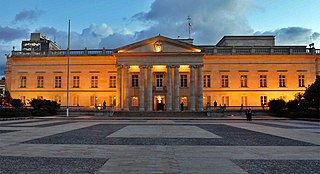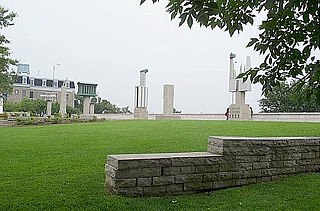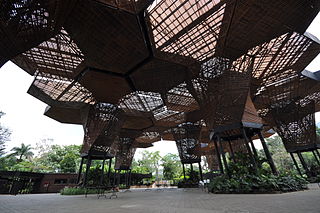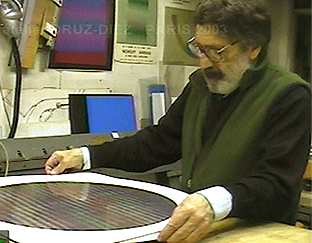The history of Colombia includes the settlements and society by indigenous peoples, most notably, the Muisca Confederation, Quimbaya Civilization, and Tairona Chiefdoms; the Spanish arrived in 1499 and initiated a period of conquest and colonization, most noteworthy being Spanish conquest of the Muisca; ultimately creating the Viceroyalty of New Granada, with its capital at Bogotá. Independence from Spain was won in 1819, but by 1830 the "Gran Colombia" Federation was dissolved. What is now Colombia and Panama emerged as the Republic of New Granada. The new nation experimented with federalism as the Granadine Confederation (1858), and then the United States of Colombia (1863), before the Republic of Colombia was finally declared in 1886. Panama seceded in 1903. Since the 1960s, the country has suffered from an asymmetric low-intensity armed conflict, which escalated in the 1990s, but then decreased from 2005 onward. The legacy of Colombia's history has resulted in one of the most ethnically and linguistically diverse countries in the world giving rise to a rich cultural heritage; while varied geography, and the imposing landscape of the country has resulted in the development of very strong regional identities.

A Paisa is someone from a region in the northwest of Colombia, including the part of the Andes in Colombia. The Paisa region is formed by the departments of Antioquia, Caldas, Risaralda and Quindío. Some regions of Valle del Cauca Department (north) and Tolima Department (west) culturally identify as paisas. The main cities of the Paisa region are Medellín, Pereira, Manizales and Armenia.

Itagüí is a city of Colombia, located in the south of the Aburrá Valley in the Antioquia Department. It is part of The Metropolitan Area of the Aburrá Valley.

Gorgona is a Colombian island in the Pacific Ocean situated about 35 km (22 mi) off the Colombian Pacific coast. The island is 9 km (5.6 mi) long and 2.5 km (1.6 mi) wide, with a maximum height of 338 m (1,109 ft) and a total area of 26 km2 (10 sq mi). Gorgona is separated from the continent by a 270 m (890 ft) deep underwater depression.
Gertrud Louise Goldschmidt, known as Gego, was a modern Venezuelan visual artist. Gego is perhaps best known for her geometric and kinetic sculptures made in the 1960s and 1970s, which she described as "drawings without paper".
The Salon of Colombian Artists is a cultural event in Colombia, considered the event with most trajectory. This event is celebrated every year between August 5 and September 12 with two main categories a national event and a set of regional contests.

The Palacio de Nariño or Casa de Nariño is the official home and principal workplace of the President of Colombia. It houses the main office of the executive branch and is located in the capital city of Bogotá, Colombia. It was dedicated in 1908 after being constructed on the site of the house where Antonio Nariño was born. The design was made by architects Gaston Lelarge, a French-born former pupil of Charles Garnier, and Julián Lombana.
Colombian art has 3500 years of history and covers a wide range of media and styles ranging from Spanish Baroque devotional painting to Quimbaya gold craftwork to the "lyrical americanism" of painter Alejandro Obregón (1920–1992). Perhaps the most internationally acclaimed Colombian artist is painter and sculptor Fernando Botero (1932).

Francisco de Asís León Bogislao de Greiff Haeusler, was a Colombian poet known for his stylistic innovations and deliberately eclectic use of obscure lexicon. Best known simply as León de Greiff, he often used different pen names. The most popular were Leo le Gris and Gaspar Von Der Natch. De Greiff was one of the founders of Los Panidas, a literary and artistic group established in 1915 in the city of Medellín.

José Javier Mejia Palacio is a recognized painter of Colombia city Medellín, son of Rita Cecilia Palacio Camargo and Francisco Javier Mejía Restrepo was born in the city of Barranquilla in 1964, but since the three months family life lies in the Antioquia capital, is related to the poet Epifanio Mejía Quijano. He has also been honored by numerous organizations such as: The Medal Peace Fenalco, Antioquia in recognition of the social work with children who participated in the program brushes for Peace in Medellín, Colombia 2003, The order of Merit Don Juan del Corral Golden Degree awarded by the City Council of the City of Medellín 2010.

The Spanish conquest of the Muisca took place from 1537 to 1540. The Muisca were the inhabitants of the central Andean highlands of Colombia before the arrival of the Spanish conquistadors. They were organised in a loose confederation of different rulers; the zipa of Bacatá, with his headquarters in Funza, the zaque of [[Boyacá Department | Boyacá]], with his headquarters in Hunza, the iraca of the sacred City of the Sun Sugamuxi, the Tundama of Tundama, and several independent caciques. The leaders of the Confederation at the time of conquest were zipa Tisquesusa, zaque Quemuenchatocha, iraca Sugamuxi and Tundama in the northernmost portion of their territories. The Muisca were organised in small communities of circular enclosures, with a central square where the bohío of the cacique was located. They were called "Salt People" because of their extraction of salt in various locations throughout their territories, mainly in Zipaquirá, Nemocón and Tausa. For the main part self-sufficient in their well-organised economy, the Muisca traded with the European conquistadors valuable products as gold, tumbaga and emeralds with their neighbouring indigenous groups. In the Tenza Valley, to the east of the Altiplano Cundiboyacense where the majority of the Muisca lived, they extracted emeralds in Chivor and Somondoco. The economy of the Muisca was rooted in their agriculture with main products maize, yuca, potatoes and various other cultivations elaborated on elevated fields. Agriculture had started around 3000 BCE on the Altiplano, following the preceramic Herrera Period and a long epoch of hunter-gatherers since the late Pleistocene. The earliest archaeological evidence of inhabitation in Colombia, and one of the oldest in South America, has been found in El Abra, dating to around 12,500 years BP.

The Ocetá Páramo is a páramo at altitudes between 2,950 metres (9,680 ft) and 3,950 metres (12,960 ft) in the Eastern Ranges of the Colombian Andes. It covers parts of the municipalities Monguí, Mongua and Tópaga, belonging to the Sugamuxi Province, Boyacá. The Ocetá Páramo is known for its collection of frailejones and other flora, as well as Andean fauna. Hiking tours from Monguí or Mongua to the páramo take a full day.

Carlos Medina is a Venezuelan visual artist. His work has been shown in Italy, France, Belgium, Yugoslavia, United States, South Korea, Austria, Hungary, Spain, Mexico, Chile, Argentina, Colombia, Panama, Costa Rica and Venezuela.

The Eastern Hills are a chain of hills forming the eastern natural boundary of the Colombian capital Bogotá. They are part of the Altiplano Cundiboyacense, the high plateau of the Eastern Ranges of the Colombian Andes. The Eastern Hills are bordered by the Chingaza National Natural Park to the east, the Bogotá savanna to the west and north, and the Sumapaz Páramo to the south. The north-northeast to south-southwest trending mountain chain is 52 kilometres (32 mi) long and its width varies from 0.4 to 8 kilometres. The highest hilltops rise to 3,550 metres (11,650 ft) over the western flatlands at 2,600 metres (8,500 ft). The Torca River at the border with Chía in the north, the boquerón Chipaque to the south and the valley of the Teusacá River to the east are the hydrographic limits of the Eastern Hills.

























